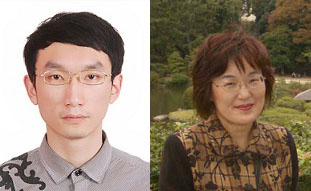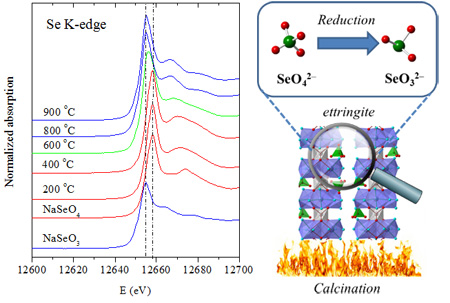Brief Report
Immobilization of selenium as a radionuclide surrogate in cement related materials for burying after solidification
Binglin Guo, D3
Keiko Sasaki, Professor
Department of Earth Resources Engineering, Faculty of Engineering, Kyushu University

研究内容
The confinement of radionuclides or hazardous elements is an important issue for preventing environmental contamination and helping to maintain safe ecosystems for living organisms. Among the radioactive isotopes, the 129I and 79Se isotopes are considered as remarkable environmental risks related to nuclear waste storage and/or disposal because of their relatively long half-life (1.57×107 and 2.95×105 years, respectively) and high mobility in soil and aqueous system. Since radioactive isotopes are relatively emergent contaminants and nuclear wastes are usually immobilized in cement, immobilization of I and Se species to cementitious materials is of great interest. As a major and active component in hydrated cement, ettringite is assumed to play a role in immobilization of toxic anions because of its ion-exchange ability. Thus, understanding the mechanism of iodine and selenium immobilized in ettringite should be investigated.
By using SAGALS Kyushu University BL, we have obtained some interesting data for supporting our speculation. Se K-edge EXAFS analysis has proved that inner-sphere complex of selenite was formed after being uptaken in ettringite. In addition, the selenate-ettringite was destructuralized after soaking in sulfate solution. However, based on Ca K-edge EXAFS spectra for solid residues after destructuralization, the coordination number of Ca and atomic distance between Ca and O was not changed even though the XRD patterns of ettringite was not observed. This suggests that the ettringite columnar structure was preserved. In addition, Se K-edge XANES spectra proved that the selenate uptaken in ettringite was reduced to selenite by calcination (Fig. 1). These data are quite important for understanding the selenium migration in ettringite under high temperature conditions.

関連業績
学術論文
- Binglin Guo, Keiko Sasaki, Tsuyoshi Hirajima,
Characterization of the intermediate in formation of selenate-substituted ettringite.
Cement and Concrete Research,99 (2017) 30–37. - Binglin Guo, Keiko Sasaki, Tsuyoshi Hirajima,
Selenite and selenate uptaken in ettringite: Immobilization mechanisms, coordination chemistry, and insights from structure.
Cement and Concrete Research, 100 (2017) 166-175. - Binglin Guo, Keiko Sasaki, Tsuyoshi Hirajima,
Solidification of ettringite after uptaking selenate as a surrogate of radionuclide in glass-ceramics by using industrial by-products.
Journal of Materials Science, 123 (2017) 12999-13011. - Binglin Guo, Keiko Sasaki, Tsuyoshi Hirajima,
Structural transformation of selenate ettringite: a hint for exfoliation chemistry.
RSC Advances, 7 (2017) 42407-42415.
学会発表
- Binglin Guo, Keiko Sasaki, Tsuyoshi Hirajima,
Removal of selenate by co-precipitate with ettringite in aqueous solution.
Goldschmidt, 2016. - Binglin Guo, Keiko Sasaki, Tsuyoshi Hirajima,
Coordination chemistry of selenate in ettringite.
Proc. the 18th International Conference on Heavy Metals in the Environment (ICHMET), 2016 - Binglin Guo, Keiko Sasaki, Tsuyoshi Hirajima,
Solidification of selenate-bearing ettringite in glass-ceramics by using industrial by-products.
Proc. the 14th International Symposium on East Asian Resources Recycling Technology (EARTH), 2017. - Binglin Guo, Keiko Sasaki,
Immobilization of iodine species in ettringite and the inorganic anions selective mechanism.
Goldschmidt, 2018 - Keiko Sasaki, Binglin Guo,
Reduction of selenate in ettringite by calcination,
Goldschmidt, 2018.
競争的研究資金名
科学研究費補助金 基盤研究(A)16H02435「放射性核種埋設に向けたジオミメティクスに由来する新規吸着材の開発」

